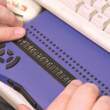Section 508 'not as hard as people thought'

A year ago, many industry and government executives were looking ahead to June 25, 2001, as a "panic day," said Terry Weaver, director of the Center for IT Accommodation at the General Services Administration.
A year ago, many industry and government executives were looking ahead to June 25, 2001, as a "panic day," said Terry Weaver, director of the Center for IT Accommodation at the General Services Administration. On that day, a new federal procurement regulation would take effect, requiring agencies to buy electronic and information technology that is accessible to people with disabilities and to create accessible Web pages. Many in industry were struggling to understand the standards so they could make products the government would buy. Many in government felt similarly pressured: They faced the threat of lawsuits and administrative complaints if they did not accurately interpret the standards and buy the best accessible products. "There was a huge fear factor a year ago. Some people had no idea what Section 508 is and how they had to change their Web sites," said John McKeown, a senior software architect for GTSI Corp., an IT reseller in Chantilly, Va.But the fears, it turned out, were largely groundless. As the first anniversary of the Section 508 rule approaches, McKeown, Weaver and others said that while much work remains in order to achieve a government powered by fully accessible IT, great strides have been made. Some organizations, such as the U.S. Postal Service, have even tried to go beyond what the law requires. The Postal Service assessed its 650 major Web sites and IT systems ? even those created before the June 25 date ? to see where they could be made compliant with the accessibility requirements. "We took the approach that the customer isn't going to know and won't care when a particular application or document was created" ? customers want all applications to be accessible, said Ray Morgan, manager of the Section 508 program for the Postal Service. So far, 480 Web sites and systems have been brought into compliance, he said.McKeown, who works on GTSI's Web site, said meeting the accessibility requirements is "not really as hard as a lot of people thought it was going to be." Improvements to technology made because of Section 508 help McKeown, who is visually impaired, do his job more effectively.But both government and industry officials still cite examples of the others' failure to understand the Section 508 requirements. "There are a lot of medium and small companies that still know nothing about Section 508. Medium and small agencies, especially those outside [Washington], still don't know about Section 508. If they don't ask, companies will not think it is such a big deal. The one-year anniversary gives us an opportunity to see what still needs to be done," said Laura Ruby, program manager of regulatory and industry affairs for the Accessible Technology Group at Microsoft Corp., Redmond, Wash.Government, industry and disability group officials are continuing their efforts to educate both government and industry employees about IT accessibility, often appearing together. GSA recently procured a Section 508 training CD-ROM. Produced by Anteon Corp. of Fairfax, Va., the CD-ROM will be distributed throughout federal agencies. Last month, GSA opened a lab in its Washington headquarters where federal employees can test assistive technologies such as screen readers for the blind.Overall, it does not appear that complying with Section 508 standards has caused a major drain on resources, which last year the U.S. Access Board estimated would cost government and industry $177 million to $1.1 billion annually. Neither industry nor government officials said they can estimate spending on compliance with the Section 508 standards, largely because designing and buying accessible products have simply been assimilated into their business processes.The collaboration of government, industry and the disability community has been key to the progress made so far, officials said. Government needs industry to produce the accessible products it needs to buy, and industry needs to understand government requirements in order to capture some of the $50 billion the federal government spends on IT annually. Input from people with disabilities is crucial to understanding their needs."We are not driving this train. We need these people together because they own the products we need to buy," said Weaver, a key figure in the government's efforts to educate employees about Section 508.Because of their continuing dialog, industry and government officials now better understand Section 508 requirements. Many initially thought the regulation required that all products and Web pages must be accessible by June 25 last year. In reality, IT products and services purchased by the federal government after that date, with few exceptions, must be accessible. Web pages created or altered after that date must also be accessible."We are beginning to see a more nuanced understanding of accessibility," said Paul Schroeder, vice president of government relations for the American Foundation for the Blind in Washington. More IT buyers and sellers understand what Section 508 is and why it is important, and now they have more specific questions, such as how to verify vendors' claims that their products are accessible, he said. "Every large corporation in the IT business has a 508 program or manager keeping up with the competition and making sure agencies are ... requiring Section 508," said accessibility consultant Rex Lint, who serves as chairman of the Section 508 working group of the Information Technology Association of America, an Arlington, Va.-based trade group.Implementation has been successful in that 95 percent of federal procurements for electronic and information technology since June 25 have included some Section 508 requirements, said Monica Dussman, corporate Section 508 coordinator for systems integrator Science Applications International Corp. of San Diego. "I call that a success story," Dussman said.But some agencies aren't writing their solicitations correctly, causing difficulties for vendors, she said. The regulation requires that the agency identify in the procurement document the specific accessibility standards that apply to the purchase. "Most procurements are coming out with a blanket paragraph that says 'Comply with Section 508.' Then we don't know specifically what [standards] we have to comply with," Dussman said.Requiring bidders to certify blanket compliance with the accessibility standards is an attempt to shift the burden for compliance onto the vendor, said Michael Mason, a Washington attorney who advises ITAA on Section 508. The procurement rule states the government buyer must identify specific standards that apply to the project and conduct market research to find accessible products. Government buyers said it's sometimes difficult to assess which vendors' products are most accessible. Some vendors use a voluntary template to illustrate how their products meet the standards. But because there is no standard way to describe products, vendors use different terminology, which creates more work for buyers, said Ken Salaets, director of governmental relations for the Information Technology Industry Council, a trade group in Washington.ITIC is developing guidelines on how to fill out the template, Salaets said. Until a common language is established, Wheaton, Md., accessibility consultant David Poehlman advises agencies to follow the lead of the Social Security Administration. Rather than struggling to interpret varying statements of accessibility, agency employees identify companies that produce the IT solutions they need, then call to ask about the products' compliance with the Section 508 requirements."The best way to do it is to get a long list of companies that do what you need, and talk to them and find the best solution," Poehlman said. "When [Social Security] calls a company and says, 'I'd like to contract you if possible,' any company worth its salt is probably going do say, 'OK, what can we do?' " XXXSPLITXXX-Vendors who make the best accessible information technology products may have a competitive advantage in the marketplace, while those who don't alter their products will eventually find themselves shut out of the federal market, experts said.Already, some vendors have seen a boost in sales directly attributable to Section 508. "Our sales related to accessibility have grown tremendously," said Dana Louise Simberkoff, vice president of business development for Hiawatha Island Software Inc. of Concord, N.H. Systems integrators use the company's desktop and automated server solutions to fix and monitor Web sites they create for federal customers; federal agencies use the products as well, she said."Organizations are realizing they need to incorporate accessibility into their development practices. A year ago, it was more of an afterthought. They developed a site, put it out, and then said 'We need to check it,' " Simberkoff said. "Now they realize it's much more cost-effective to be design accessible from the ground up."Greg Lorden, vice president of government for Business Objects, a San Jose, Calif., company that produces business intelligence software, said his firm is trying to use Section 508 as a competitive weapon. Lorden said he thinks his firm is the only one in the business intelligence space to incorporate the standards into its software. The company also set up a call center to answer accessibility questions. "I haven't seen where this has been a discriminator for us yet, but I would love to see that happen," Lorden said.XXXSPLITXXX-[IMGCAP(1)]Improving access to information technology for people with disabilities is not new to the Education Department, considered a leader in implementing Section 508. The department established its Assistive Technology Program in 1995. Its services include assessment of individual needs for IT and assistive technology, installation and training, guidance for system developers and vendors and review of information systems to determine accessibility.[IMGCAP(2)]Section 508 has fostered a strong working relationship between IT developers and assistive technology developers, said Joe Tozi, program director. [IMGCAP(3)]As the one-year anniversary of Section 508 implementation approaches, some agencies are taking Section 508 training beyond IT staff and purchasers to rank-and-file employees. On May 7, Office of Personnel Management staff in Washington and, via videoconference, two satellite offices, learned about Section 508 from several federal officials. They included Ken Nakata of the Justice Department, who discussed the legal requirements; Doug Wakefield of the U.S. Access Board, who discussed the technical requirements; and Don Barrett of the Education Department, who showed attendees how a screen reader helps a blind person on the job. For more information about Section 508, visit , , and .XXXSPLITXXX-The Workforce Investment Act became law in August 1998, re-authorizing Section 508 of the Rehabilitation Act of 1973. The law requires federal agencies to buy, develop, maintain and use electronic and information technology that is accessible to people with disabilities. But the drive to design, sell and buy accessible products did not begin in earnest until December 2000, when the U.S. Access Board, an independent federal agency, issued standards for accessible technology. Industry now follows the standards to design IT products; agencies use the standards to buy those products. The standards are designed to provide equal access to technologies for disabled government workers and citizens who use government Web sites. The standards apply to software and operating systems, Web-based applications and information, telecommunications products, video and multimedia products, desktop and portable computers and self-contained products, such as information kiosks. In April 2001, the Federal Acquisition Regulation Council, which sets procurement policy, issued a rule that made the standards part of the government purchasing process. Since June 25, 2001, all federal agencies have been required to buy only the most accessible products on the market unless doing so would be an undue burden on the agency. Government agencies could face administrative complaints and federal lawsuits from individuals with disabilities if the agencies purchase products that don't meet the standards. Observers said no lawsuits have been filed so far, and any administrative complaints have been quietly resolved.XXXSPLITXXX-Before Section 508, accessibility was largely an afterthought in many IT manufacturers' design processes, and assistive technology makers had a hard time getting the attention of the big guys in order to test their products with the latest hardware. When AT firms, as they are known, would ask manufacturers to lend them new computers for testing, their requests often were rejected or ignored.Now, the tables have completely turned, said Randy Marsden, president and chief executive officer of Madentec Ltd. of Edmonton, Alberta, Canada. The company makes assistive technologies, such as a device that tracks head movement and converts it into cursor control, so users can operate a computer without use of their hands. "Now, we have the big companies calling us, saying, 'We would like to test our computers with your product,' " said Marsden, who also serves as vice president of the Assistive Technology Industry Association in Evanston, Ill.Even companies with strong accessibility programs have placed greater emphasis on collaboration with AT vendors since Section 508 went into effect. Last summer, software giant Microsoft Corp. and hardware giant Compaq Computer Corp. invited AT makers to a laboratory at Microsoft headquarters in Redmond, Wash., to test their products on Compaq desktop computers running Microsoft's new XP operating system ? before XP was offered for sale. Because of their efforts, compatible assistive technologies were available for the first time with the release of a new operating system, said Michael Takemura, director of the Accessibility Program Office at Houston-based Compaq. Compaq was recently acquired by Hewlett-Packard Co. of Palo Alto, Calif.In addition to improving the quality of life and productivity of the 54 million people with disabilities living in the United States, designing for accessibility is also good business, Takemura said."I am going to sell more PCs if [people with disabilities] have the chance to buy that new PC instead of keeping their three- to six-year-old system. And, of course, assistive technology businesses want people to buy their new products. They don't want someone to use their seven-year-old products," said Takemura, who serves on the board of directors of the Assistive Technology Industry Association.The increased cooperation between AT vendors and IT vendors has led to a collaboration on interoperability standards under the umbrella of the Information Technology Industry Council. Government and consumer groups will have input to the group's work, said Ken Salaets, director of governmental relations for ITIC.The vendors this month will publish guidance on the ATIA Web site for developers seeking to make IT products compatible with AT products. Ultimately, the vendors hope to establish interoperability standards that will allow AT and IT to work together out of the box."AT-IT interoperability is not a new concept. What we are doing that is different and exciting is we are trying to work together to do a better job of supporting the assistive technology industry as a whole. In the past, each vendor has worked with companies separately," said Laura Ruby, program manager of regulatory and industry affairs for Microsoft's Accessible Technology Group."When you have interoperability in place, it should simplify the government's ability to meet the needs of its employees and save government and industry a lot of money," Salaets said. "Ultimately, accessibility is going to be ubiquitous."

Staff Writer Gail Repsher Emery can be reached at gemery@postnewsweektech.com.



www.section508.govwww.access-board.govwww.accessibilityforum.org

Assistive technology engineer Ken Praul uses a braille reader at his computer workstation, one of the technologies used and tested at the Assistive Technology Lab at the Department of Education.
Staff Writer Gail Repsher Emery can be reached at gemery@postnewsweektech.com.

Joe Tozi, director of the Assistive Technology Program for the Education Department, pauses in the ATP lab.

Doug Wakefield & Ken Nakata

At the May 7 OPM training session, Don Barrett of the Education Department demonstrates how a screen reader helps a blind person on the job.
www.section508.govwww.access-board.govwww.accessibilityforum.org
NEXT STORY: WebMethods builds fed unit

